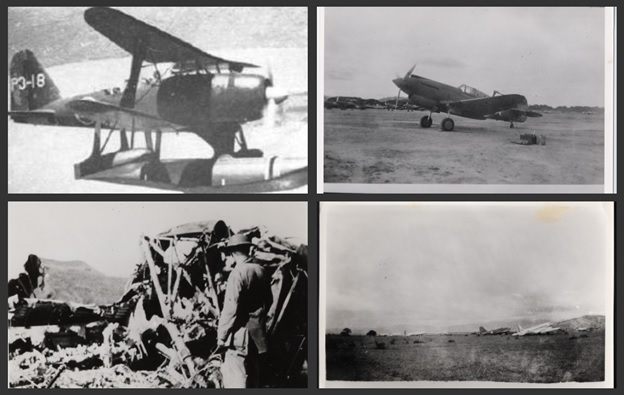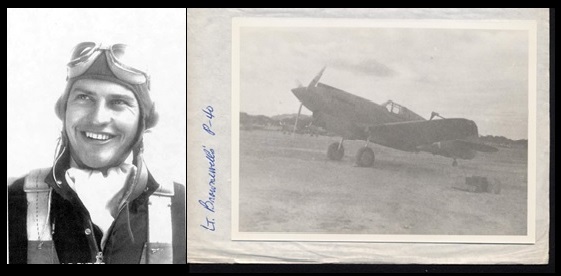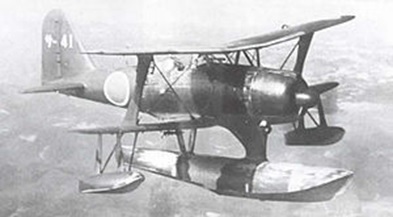The Last Days of Lt. John P. Burns, 21st Pursuit Squadron, KIA Dalirig Airstrip, Bukidnon
Lt. Burns was a fighter pilot with the 21st pursuit squadron based in Del Monte, Bukidnon. The events of his life in Mindanao were recorded by Lt. Burns, written in a leather bound diary. How the diary ended up in the hands of the Burns family turned out to be a story in itself.
John Patterson Burns was born on September 22, 1917, in Mansfield, Ohio, and graduated from Uniontown High School in 1936. In June 1940, he graduated from Ohio University with a degree in electrical engineering and a commission in the Infantry of the Army Reserve. Burns received his wings from Kelly Field on February 7, 1941, in the class of 41A, fulfilling a childhood ambition. He was subsequently assigned to the 21st Pursuit Squadron of the 35th Pursuit Group at Hamilton Field, California, where he served until his squadron and the sister 34th Pursuit Squadron were ordered in October 1941 to “PLUM”, the code name for the Philippines.
His diary left us with a first person account as to what happened to the remnants of the battered American air force in Mindanao in 1942
Some of his entries…
November 1, 1941
“Left San Francisco at noon on the S.S. President Coolidge. An awful day to be starting to go someplace and not know where. Under the Golden Gate bridge at last; by boat, damn.”
November 21, 1941
“Reported to Nichols Field this morning and N.F. is PLUM for the present. We are to be someplace in the P.I.’s. We are not happy about it.”
Nichols Field was just south of Manila, where the 17th Pursuit was currently based. Because the movement of American pilots from the US to the Philippines was “top secret” evidently the 21st and 34th Pursuit pilots still thought that PLUM was a base in the Philippines to which they were being assigned.
November 29, 1941
“Today we went on a 24 hr. alert. Available at all times. Moving within three days. All planes fully loaded and charged at all times. Looks like they mean business. Called to field at 9:00 p. Practice.”
Maj. Gen. Brereton had issued an order putting the FEAF on a “readiness” alert. The pursuit pilots including the 21st and the 17th at Nichols Field–were put on one hour’s notice to take off in their combat-loaded P-40Es and intercept in the event of a Japanese attack.
December 8, 1941
”Two alerts before daylight. War started. Had patrol about noon. Moved to C.F. just before dark. C.F. bombed to hell and while we were patrolling over N.F. No air defense at C.F. Complete surprise.”
C.F. = Clark Field
April 7, 1942
“Up early, left for Cebu before daylight. Spent day there in Civilization [sic], it doesn’t seem possible, good food, no bombers. I felt like a kid with a new toy. Left for Del Monte, arriving at dusk.”
April 8, 1942
“Today starts the 5th month of this mess and a new era for me. It is wonderful here. Hardly know a war is going on. Food much better as a whole than Bataan.”
The Japanese has not yet invaded Mindanao; it has been barely a month since four stars general Douglas MacArthur took a ride on a B-17 bomber to Australia.
April 9, 1942
“Rested all day. Reported in morning that things are very bad at Bataan. In evening reported that Bataan has fallen. Corr. Still holding though. Those poor guys there. I wonder how long it will be here.”
April 10, 1942
“Another lazy day. Not much news of Bataan. Terms being arranged. Cebu attacked. Quite a few of the pilots got out of Bataan. We wonder who. Lundee trying to get us on south from here. Dyess stayed on-naturally.”
April 11, 1942
“Day quiet. At supper time 10 B-25s and 3 B-17Es came in. Going to do a bit of bombing then back and chance to move on south. I hope I get it. Was a wonderful sight to see them come in.”
At about 5:00 that afternoon, the personnel at the Del Monte Field were startled when three B-17s and 10 twin engine bombers (B-25’s) of a type they had never seen before approached the field and came in to land. Headed by Maj. Gen. Ralph Royce, they were on a special mission from Australia to raid targets on Cebu (central Philippines), Mindanao, and (for the B-17s) Luzon. The pursuit pilots were to provide support for their operations.
April 12, 1942
(No entry).
April 13,1942
(NoEntry)
Japanese floatplanes–Mitsubishi “Pete”-operating in pairs appeared over Del Monte field in the early morning and made unsuccessful bombing attempts on the three B-17s on the ground. The Pete’s were Mitsubishi F1M2 launched from the Imperial Japanese Navy sea plane tender “Sanuki Maru”, that covered the landings of the Kawaguchi Detachment’s 35th Infantry Brigade HQ and the 124th Infantry Regiment in Cebu. SANUKI MARU was with the light cruiser KUMA, Destroyers’ SAMIDARE, MURASAME and KIJI, the gun boat BUSHO MARU and two sub-chasers. The Pete’s mission was to destroy the American air force base in Del Monte fields before their bombers can wreak havoc on the Japanese shipping and their invasion of Cebu.
At the satellite fighter strip at Dalirig, eight miles south of Del Monte field, Gus Williams and John Brownewell (17th Pursuit) took off on the morning of April 13th for a strafing mission of Davao. Then they spotted two Pete’s over the area and in a dogfight Brownewell shot one down, but Williams’ “P-40 Something” went into wild gyrations in climbing, then its engine quit. Williams managed to get his malfunctioning ship down safely, however.

Clockwise: (1) A Japanese “Pete”. The Mitsubishi F1M2 is a two seater Bi-plane manned by a pilot and a rear gunner. It is a multi-role aircraft that is used by the Japanese as an observation plane, bomber, and fighter. (2) The last functioning P-40 on that day was used by Lt. Brownewell to shoot down one of the four “Pete”. It was refueled and armed when Lt. Burns took off, only to crash upon take off killing Lt. Burns. (3) The Del monte Airfield with 2 transport planes. (4) American soldier checking out the wreckage of the Japanese plane that was shot down by Lt. Brownewell over Dalirig.
About 12:35, a report came in from an observer post that the bothersome Japanese float planes were again approaching the area and that the one P-40 on the field at the time (a P-40E, perhaps Brownewell’s on his return from the Davao mission?) should be used to intercept. As the alert officer had gone for lunch five minutes earlier, Burns was left to take the mission. In his take-off roll, he failed to hold the ship in the center of the 200-foot wide runway and veered off into large rocks that lined both sides of the strip. The P-40E plunged over the side of the canyon that bordered the field and caught fire. No one could reach him in time and there was no firefighting equipment at the field. Burns burned to death in the cockpit. Unmolested, The Japanese Mitsubishi Pete’s were able to deliver their bomb load and destroyed a B-17E and damaged two others.
That evening the chaplain and friends buried him in a little graveyard in a grove of trees.
One of the pilots who saw Lt. Burns’ crash wrote this last entry in John’s diary:
April 13, 1942
” Killed in takeoff in attempt to intercept Jap bombers. John died quickly and bravely, the way if they have to, all pilots want to die.”
Sadly, he was reportedly on the list of pilots the Royce mission was to evacuate on its return flight to Australia.
General Royce’s letter to the parents of Lt. John P. Burns on January 30, 1943. “On the second day of our stay at Del Monte field on Mindanao, we had stationed some P-40 fighters on the airdrome which were held on alert to drive off the enemy low-flying dive bombers which had been bothering us the day before. Your son was on duty as airdrome, and about half past twelve the officer who was on the alert with the P-40 asked your son to take the alert while he got a bite of lunch. About five minutes later, the alert sounded and your son jumped in the P-40, had the engine started, and started to take off the runway. We never knew exactly what happened, but the ship ran off to the side of the runway and the sharp rocks blew off the tires. He tried to get airborne before sufficient speed had been obtained and stalled the engine. It crashed to the earth, plunged over the side of a hill and burned up. I investigated the accident as much as possible, and found that while your son was not ill at the time, yet he had not been in the best of health, and I think he must have fainted as started down the runway. The doctor and chaplain and a few of his friends buried him at night in a grove of trees. Your son’s record was an enviable one.”
Lt. John Burns diary’s journey home.
According to Rev. Burns, Lt. John Burns’ younger brother the diary was received in a package in 1945 from an American soldier who had been engaged in the seizure of Buna, New Guinea, from the Japanese in early January 1943. The soldier indicated that he had taken the diary off the body of a Japanese soldier killed in the battle. Following his return to the U.S. at the end of the War, the American soldier–whose name is no longer remembered–was able to locate the Burns family to return the diary.
The Japanese soldier must have been a member of the 41st Infantry Regiment, which on May 9, 1942, had captured the American air base at Del Monte, Mindanao and its satellite fields, ending the Philippines campaign. The 41st Regiment was subsequently assigned to the New Guinea campaign, arriving in July 1942. It fought its last battle in defense of Buna in early January 1943, at which time the Japanese soldier was evidently killed.
One wonders how the Japanese soldier came into possession of Burns’ diary and why he was carrying it on his body at the time he was killed. Burns had been killed in an accident taking off from Dalirig strip, Mindanao, on April 13, 1942, and was buried at nearby Del Monte that evening. It is likely the chaplain who buried him–probably Joseph V. LaFleur, the chaplain of the 19th Bomb Group who was at Del Monte at the time–found the diary in Burns’ living quarters and kept it for return to the family as part of his duties. His intention would have been thwarted when he was taken prisoner with the rest of the surrendering American force at Del Monte and turned over the “souvenir” when ordered by the Japanese.
The diary provides an invaluable day-by-day account of the activities of Burns from the time of his departure from the U.S. on November 1, 1940 through April 11, 1942, two days before his death. It is the only contemporary source that exists of the initial operations of the 21st Pursuit Squadron and its subsequent experiences on beach defense and at Bataan Field in January, February, and March 1942.
For full text of the Diary, please click here
Doomed at the Start: American Pursuit Pilots in the Philippines, 1941-1942 (Williams-Ford Texas A&M University Military History Series) is a must read book if one must know about the 21st Pursuit squadron in the Philippines during World War 2.
I also used the book Flying Cadets of World War II for additional references.
Kerwin Salvador P. Caragos






